Joan Yeguas
The Museu Nacional d’Art de Catalunya looks after a collection of almost 1,400 works in the Renaissance and Baroque Art collection, most of which are in the storerooms. Like other museums, a percentage of the total is usually loaned out to different entities or public bodies.

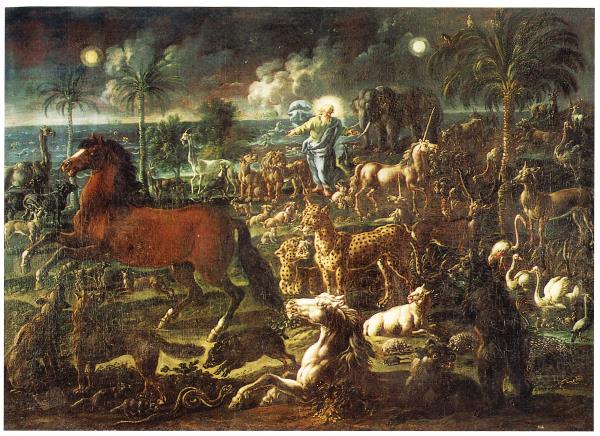
One of these cases arises in the Palauet Albéniz, or Royal Pavilion of Montjuïc, a place close to the museum, owned by Barcelona City Council, which was also built for the 1929 Universal Exposition in Barcelona. At the present time, there are 83 works from different periods on loan from the Museu Nacional in it, including a series of six large-format paintings (127.5 x 181 cm). They are works on a religious theme that depict episodes from the Old Testament, particularly from the Books of Genesis and Exodus. In this case, curiously, they feature landscapes and animals heavily, something that places them within the genre of animal art, that is, the depiction of animals in natural surroundings.
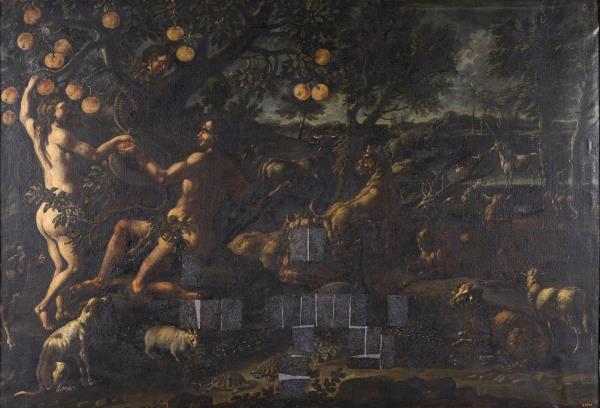
The episodes depicted in the paintings of Cajetan Roos
In chronological order according to the Bible, the episodes are:
- Creation of animals, with God the Father elevated in the centre of the composition, above clouds, and a multitude of land animals, sea creatures and birds;
- Eve tempts Adam with the apple, surrounded by flora and fauna;
- Animals entering in Noah’s ark, an enormous stream of animals stand in line to enter the ark before the arrival of the Flood;
- The Flood myth, a depiction of the power of the water, how it sweeps away everything in its path;
- Noah’s Ark in Mount Ararat, the moment when the flood waters recede and the different animals begin to emerge from the ark; and
- Moses makes the water gush out of the rock, the only work corresponding to the Book of Exodus, when the patriarch strikes the rock at Horeb, water gushes out of it, and different people were gathering or drinking it.
Identifying the artist who painted the works
The group of six paintings entered the museum in 1950 as the bequest of Concepció Caritg i Figueras. From the start, the works were attributed to an artist called “La Rose” and given a generic 18th-century date. For years we have wondered who this painter with a French-sounding surname was. There are landscapes by Jean-Baptiste de La Rose (Marseille, 1612 – Toulon, 1687), and by his son Pascal de La Rose (Toulon, 1665-1745), also a landscape artist. But the style of the works in Barcelona does not in any way resemble that of these French painters.
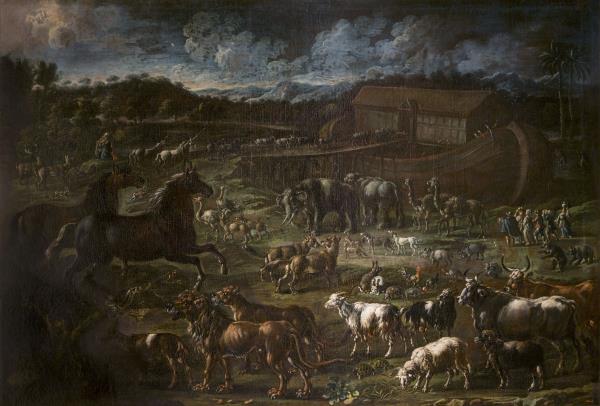
On the other hand, the composition and the way of working perfectly match the work of Cajetan Roos (Rome, 1690 – Vienna, 1770), also known as Gaetano De Rosa, or simply Gaetano Rosa. A painter of Germanic heritage, born in Rome, the son and grandson of painters, his father was Philip Peter Roos, also known as Rosa da Tivoli, because from 1684 to 1691 he lived in Tivoli, just over 30 km from the eternal city, where he painted the landscapes, people and animals in the Roman countryside. His paternal grandfather, Johann Heinrich Roos (1631-1685), was also a painter, and his maternal grandfather was Giacinto Brandi, a member of the Academy of the Virtuosi al Pantheon and the Accademia di San Luca, and quite a well-known Italian painter.
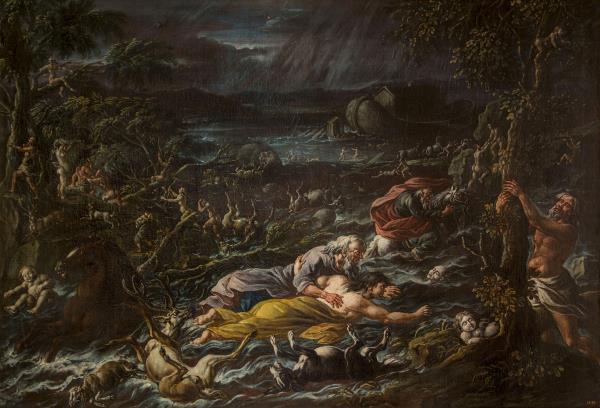
Cajetan Roos’s father, Philip Peter, is thought to have been one of the most prolific animal painters in Italy in the second half of the 17th century, and an artist who determined the pastoral genre of his day, since he influenced the work of later artists, in the 18th century, such as Domenico Brandi, Alessio De Marchis, Andrea Locatelli, Francesco Londonio, and other Central European painters who were in Rome. Cajetan had five children, two of whom worked as painters: Jacob (1682-c. 1730) and Cajetan. Both brothers painted themes similar to those their father did, and signed the canvases “Rosa”, the Italian version of the surname; perhaps a signature could have been read years ago on one of the paintings in the series, something that might explain the first attribution. Cajetan’s works differ from those of his fatherand brother due to the style, and also to a greater presence of the landscape. Animals feature prominently: in the foreground, great plasticity is conferred upon both them and the human figures, with a very linear profile; on the other hand, seen in the distance, they are merely blotches sketched with a few brushstrokes.
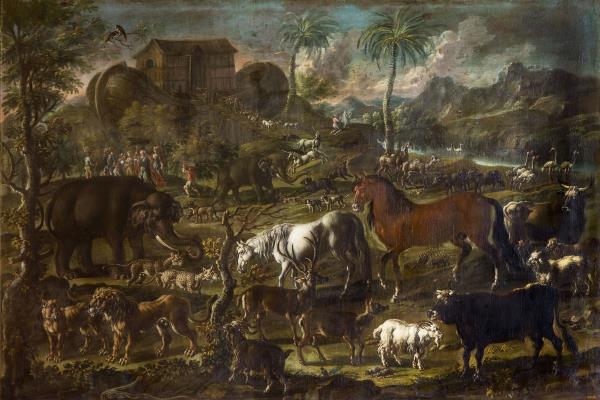
The style of Cajetan Roos
One of the works that marks the style of Cajetan Roos is The Creation of the Animals (whereabouts unknown), signed and dated as “Gaetano Rosa 1718” (cited by Bocchi, G. and Bocchi, U., Pittori dei natura morta a Roma. Artista stranieri 1630-1750, Viadana, 2004, p. 283); there is another version of this scene, sold in London on 8 December 2016 (Bonhams, lot no. 27), signed “Rosa F(ecit)”, and, at the same time, the two of them are very similar in composition to the painting in the Barcelona series, even in the arrangement of the trees.


Roos Family, Animals entering in Noah’s ark, 1750 (auctioned at Sotheby’s Amsterdam in 2010); and Cajetan Ross, Animals entering in Noah’s ark (auctioned at Bonhams London in 2016)
Another composition that has many known versions is The Animals Entering Noah’s Ark: a first one, but smaller format (101 x 152.3 cm), auctioned in New York on 26 January 2005 (Christie’s, lot no. 297), and later sold in Paris on 28 June 2006 (Millon & Associés, lot no. 33); a second, signed and dated “M. Rosa / 1750”, auctioned in Amsterdam on 18 May 2010 (Sotheby’s, lot no. 28); a large-format third one (123 x 176 cm), sold in the abovementioned London auction in 2016 (in the same lot); and the one in Barcelona. They are all very similar due to the background landscape and the position of the ark, but the animals are in different positions.
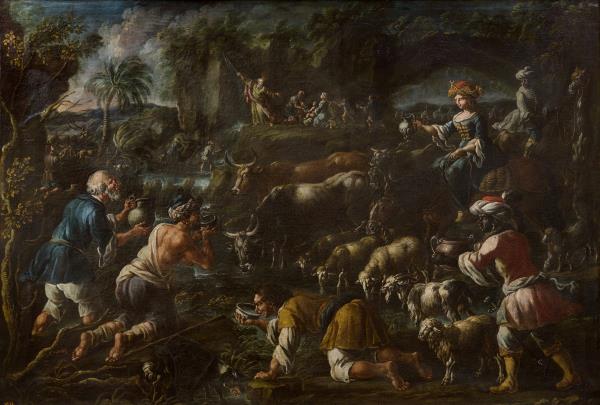
And, finally, Moses Makes the Water Gush Out of the Rock has an almost identical composition to that of a painting that was auctioned in Rome on 6 June 2002 (Finarte, lot no. 660), wrongly identified iconographically with the title Landscape with Animals and Shepherds.
Related links
Rethinking the Collection: new attributions in the Renaissance and Baroque
Opening of the new Renaissance and Baroque galleries!
Art del Renaixement i Barroc







